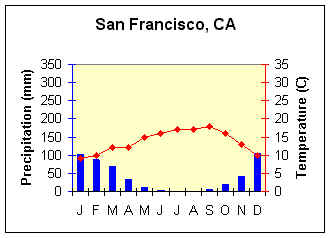Mediterranean or Dry Summer Subtropical ClimateThe Dry Summer Subtropical climate, is also known as the "Mediterranean" climate because the land that borders the Mediterranean Sea is a type locality for this climate. The wet winter/dry summer seasonality of precipitation is the defining characteristic of this climate. Summer drought places a great deal of stress on the local vegetation, but plant structures have evolved to adapt to it.
Small, thick evergreen leaves of the schlerophyll forest combat water loss during the drought conditions of the dry summer. Figure 9.14 depicts a schlerophyll scrub forest in the subalpine zone in New Zealand.
|
 |
Figure 9.15 Climograph
for Latitude/Longitude = 37.45 N; 122.26 W |
Controlling Factors
The main controlling factor over the characteristics of the dry summer subtropical climate is the alternating influence of the subtropical high in summer and Westerlies during the winter. During the summer, the subtropical high has expanded to its largest extent and most poleward position, exerting its influence on subtropical west coasts between 30o and 40o N and S latitude. Subsiding air from the high creates stable atmospheric conditions when coupled with cold ocean currents along these coasts. During the summer, stable maritime tropical air masses and cT air masses dominate.
During the winter the subtropical high shifts to the south and its influence is replaced by the Westerlies associated with the subpolar low. During this period, mT, mP, and cP air masses invade the climate. Midlatitude cyclones formed in the Westerlies bring much needed precipitation during the winter.
Distinguishing Characteristics
Temperature
It's no wonder the cradle of civilization is found in the dry summer subtropical climate. The temperature is moderated by nearby large bodies of water making for comfortable conditions throughout most of the year. Temperatures around the Mediterranean coast are higher than the dry summer subtropical climates bordered by colder ocean water. No monthly temperature falls below 0oC (32oF) and has at least 3 months that average above 10oC (50oF). Warmest monthly means are in the upper 20os C (70oF to 80oF). The stable atmosphere creates cloudless conditions giving the dry summer subtropical climate many days of sunshine. The cloudless conditions commonly experienced during both the daytime and night cause significant heat gain and loss over the course of the day. As a result, this climate experiences a large daily temperature range during the summer. Though the climate is typified by its mild temperatures, frost danger does occur during the winter when cP air masses penetrate the region.
Precipitation
The most distinguishing characteristic of the dry summer subtropical climate is its seasonal precipitation regime. As discussed above, the dry summer is due to the presence of the subtropical high. The subsidence of the subtropical high suppresses cloud development and precipitation. Additionally, the presence of a cold ocean current along the western coast of the United States helps to stabilize the air, further reducing the chances for rain. The cloudless skies during summer, however, increase the absorption of insolation by the polluted atmosphere of many large urban centers in places like southern California causing problems of photochemical smog.
During the winter, the subtropical high shrinks and moves away from the climate and the subpolar low with its associated cyclone belts moves in. Uplift provided by cyclonic circulation brings much needed rain to this region. However, intense down pours can cause rapid runoff and initiate landslides on unstable slopes.
 Figure 9.16 Golden Gate Bridge in San Francisco, CA enveloped in fog.
(Source: NOAA. Click image to enlarge)
Figure 9.16 Golden Gate Bridge in San Francisco, CA enveloped in fog.
(Source: NOAA. Click image to enlarge)
Many coastal dry summer subtropical climate regions
experience frequent fogs. In North America, the dry summer subtropical is
strongly influenced by a cold ocean current. As warm, moist Pacific air
travels over the colder ocean water of the California Current it is
chilled. Cooling the air by contact brings the air to its saturation point
causing condensation and the development of an
advection
fog.
 Figure 9.14 Schlerophyll scrub forest
in the subalpine zone in New Zealand. (Photo credit: T. Detwyler
Optilearn Inc. Photo from the World
Biomes CD-ROM Used with permission)
Figure 9.14 Schlerophyll scrub forest
in the subalpine zone in New Zealand. (Photo credit: T. Detwyler
Optilearn Inc. Photo from the World
Biomes CD-ROM Used with permission)
